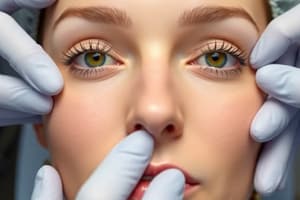Podcast
Questions and Answers
What is periorbital edema?
What is periorbital edema?
Swelling of soft tissue around the eye.
Which of the following is a systemic cause of periorbital edema?
Which of the following is a systemic cause of periorbital edema?
- Dry skin
- Infection
- Allergies
- Hypothyroidism (correct)
Pitting edema occurs when pressure is applied and leaves a depression.
Pitting edema occurs when pressure is applied and leaves a depression.
True (A)
What are common features observed in a patient with Parkinson's?
What are common features observed in a patient with Parkinson's?
What causes Bell's palsy?
What causes Bell's palsy?
What is the prognosis for Bell's palsy?
What is the prognosis for Bell's palsy?
The primary bacterial agents causing impetigo are ___________ and ___________.
The primary bacterial agents causing impetigo are ___________ and ___________.
What is a common characteristic of erysipelas?
What is a common characteristic of erysipelas?
What notable issue do patients with Bell's palsy experience relating to eye function?
What notable issue do patients with Bell's palsy experience relating to eye function?
Flashcards are hidden until you start studying
Study Notes
Facial Observation in Ocular Disease
- Examine patient's face for symmetry, complexion, rashes, and lesions.
- Conditions to note include skin cancers, neurological disorders, rosacea, and eczema.
- Facial symmetry assessment includes checking eyebrows, eyelids, and overall facial appearance.
Periorbital Edema
- Defined as swelling of soft tissue around the eye, appearing "puffy."
- Causes can be systemic (kidney, hypothyroidism) or localized (allergies, infections).
- Systemic causes often lead to significant conditions requiring medical attention.
Pitting Edema
- Characterized by depressions left after applying pressure to swollen areas.
- Nephrotic Syndrome is a major systemic cause, linked to kidney disease; swelling appears around the eyes upon waking and may progress to ankles later in the day.
Myxedema and Hypothyroidism
- Florid Myxedema results from severe hypothyroidism, causing skin swelling and thickening without pitting.
- Symptoms include dull skin, puffy facial appearance, and dry, coarse hair.
Facial Features in Parkinson’s Disease
- Notable for a mask-like face and decreased blink rate, contributing to dry eye symptoms.
- Patients often exhibit a classic stare, with a forward flexed neck and upper body.
Neurological Impacts on Facial Symmetry
- Differentiate between lower and upper motor neuron defects by observing forehead wrinkles.
- Lower motor neuron issues, such as Bell’s palsy, cause paralysis affecting both upper and lower facial structures.
Bell’s Palsy
- Acute unilateral facial paralysis due to facial nerve inflammation, commonly viral (e.g., herpes).
- Limited ability to blink, asymmetric smile, and forehead wrinkles present only on one side.
- Good prognosis with a 90% recovery rate; up to 20% may experience residual weakness.
Upper Motor Neuron Defects
- Central lesions (CNS-related) lead to lower face weakness, while brow lifting and forehead wrinkling remain intact.
- Associated with conditions like multiple sclerosis and strokes.
Facial Complexion and Skin Conditions
- Inspect skin for rashes, blemishes, and lesions, and inquire about dermatological history.
- Skin conditions generally categorized into infectious, metabolic, contact dermatitis, and neoplasms.
Bacterial Infections
-
Impetigo: Common in preschoolers and young adults, caused by Staphylococcus aureus and Streptococcus pyogenes, characterized by vesicles and "honey-colored" crust.
-
Treatment involves penicillinase-resistant oral antibiotics; topical treatment is ineffective.
-
Erysipelas: A skin infection primarily affecting older adults and diabetics, marked by tender, red, warm, and swollen patches with fever.
-
Most frequently affects the face and lower extremities, indicating significant health risks.
Studying That Suits You
Use AI to generate personalized quizzes and flashcards to suit your learning preferences.

